#bladdernut
Text
Westonbirt Arboretum
Located approximately 3 miles (5 km) southwest of Tetbury, Gloucestershire, Westonbirt, The National Arboretum is a picturesque arboretum managed by Forestry England. It forms part of the Westonbirt House estate established during the height of Victorian plant hunting in the mid-19th century. The arboretum is listed as Grade I on the Register of Historic Parks and Gardens of special historic…

View On WordPress
#arboretum#bladdernut#forestry england#george holford#japanese maple#ko-fi#lime#maples#patreon#robert holford#tetbury#trees#walnut#Westonbirt#Westonbirt Arboretum
0 notes
Text

Quick Guide to Georgian Spreads
1. Ajika: popular dip made from peppers, garlic, walnuts, herbs, spices. Though it is usually red, green ajika is also made with unripe peppers.
2. Akutaghchapa: boiled eggs filled with walnuts, similar to deviled eggs.
3. Phkali: vegetable walnut balls with spinach, beans or beetroot. It consists of chopped and minced vegetables, made of cabbage, eggplant, spinach, beans, beets and combined with ground walnuts, vinegar, onions, garlic, and herbs. The common ingredient of all variations of pkhali is puréed walnut sauce.
Pkhali is generally served with lettuce, bread and pomegranate seeds.
4. Badrijani: fried eggplant with walnut filling.
5. Mixed green salad with Georgian yogurt matsoni
6. Jonjoli: pickled flowers of bladdernut
7. Imeretian Cheese: hard cheese
8. Mchadi: corn bread
9. Mtsnili: pickled vegetables
10. Ghomi: cornmeal and cheese porridge
11. Charkhlis Mkhali: beetroot salad with walnuts
12. Abkhazian Smoked Ham
20 notes
·
View notes
Text

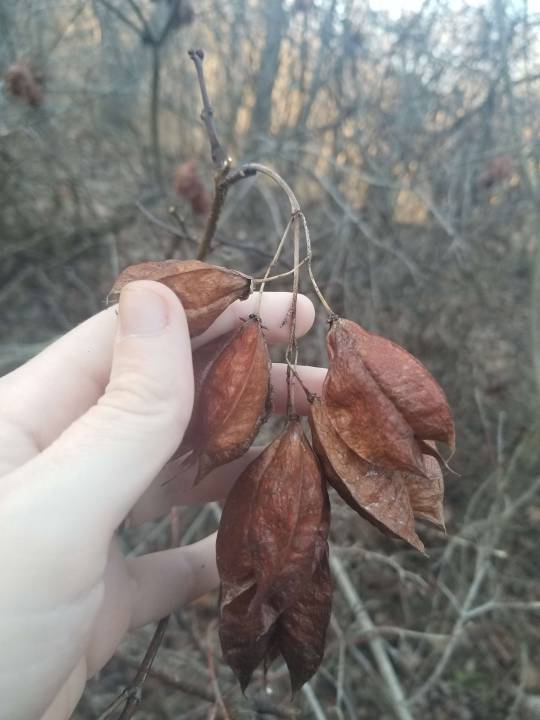

AMERICAN BLADDERNUT
Staphylea trifolia
Angiosperms/Eudicots/Rosids
Native
February 3, 2024
0 notes
Text
Species observed 5/7/2023
Virginia spiderwort
Woodland stonecrop
One-flowered cancer-root
Wood nettle
American bladdernut
Jacob’s ladder
Hedge bedstraw
Deertongue
Cut-leaves toothwort
Sassafras
May apple
Bloodroot
Canadian wild ginger
Smooth Solomon’s seal
Solomon’s plume
Jack in the pulpit
Wild geranium
Drummond’s wood sorrel
0 notes
Text
4/12/23
i grew up next to a park next to a creek next to a nature preserve and i feel very lucky for it. ive been so close to the mostly unadulterated forest for so long and i appriciate it. i love those things i love the pawpaw trees and the bladdernut and the way black wallnut smells and all the little and big flowers that pop up. theres foxes in those woods, i saw one with my own fucking eyes it was amazing. i wasnt supposed to be there it is tresspassing but i was cleaning up litter and i saw it. ive picked up crawfish with my hands i love walking along creekbeds. i love the flash storms.
they should really makes perfume that smells like black walnut i just found out they do. holy shet.
when it storms in the summer i like to stand on the porch and watch the rain ripple across the pavement when i work and its pouring i love it i love the rain.
i have 20,000 words written on a personal projects, i love it i love creation. divinity in the hands of man! im transgender and so the body becomes creation, becomes becoming. if there is a god it should be creation.
0 notes
Text
Plants with bladders?
Collected on this Day in 1940

This specimen was collected on May 29, 1940 by Leroy Henry along Pine Creek, north of Wildwood outside of Pittsburgh. Leroy Henry was a mycologist (studied fungi) and botanist who was curator at Carnegie Museum from 1937-1973.
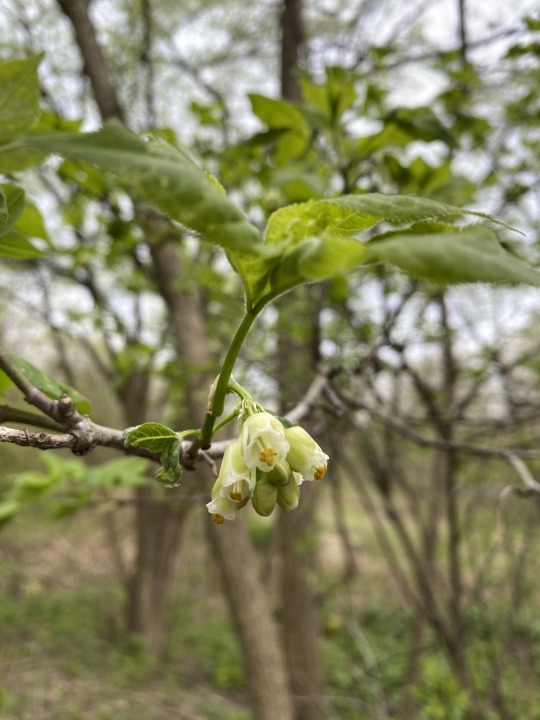
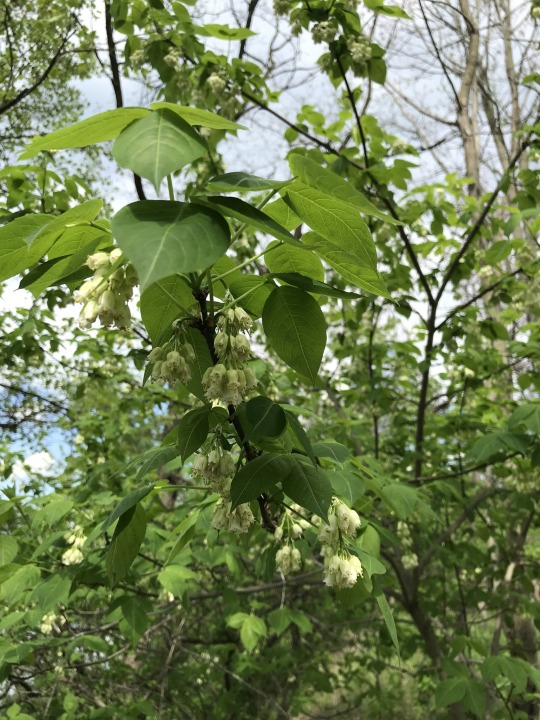
Aptly called “bladdernut” (Staphylea trifolia), this charismatic native understory shrub produces clusters of white flowers in the spring. These dangling flowers develop into striking bladder-like fruit. In each “bladder” pouch are seeds. These fruit often persist through fall and some linger through winter, though the plant is leafless.
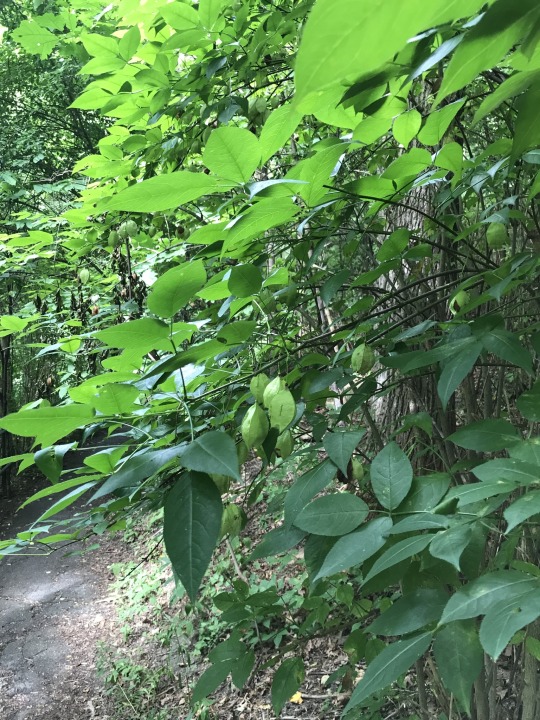
Bladdernut has a wide range across eastern North America, and can be found in relatively undisturbed forests in our area, often forming thickets.
Find this specimen here.
Check back for more! Botanists at the Carnegie Museum of Natural History share digital specimens from the herbarium on dates they were collected. They are in the midst of a three- year project to digitize nearly 190,000 plant specimens collected in the region, making images and other data publicly available online. This effort is part of the Mid-Atlantic Megalopolis Project (mamdigitization.org), a network of thirteen herbaria spanning the densely populated urban corridor from Washington, D.C. to New York City to achieve a greater understanding of our urban areas, including the unique industrial and environmental history of the greater Pittsburgh region. This project is made possible by the National Science Foundation under grant no. 1801022.
Mason Heberling is Assistant Curator of Botany at Carnegie Museum of Natural History. Museum employees are encouraged to blog about their unique experiences and knowledge gained from working at the museum.
33 notes
·
View notes
Photo
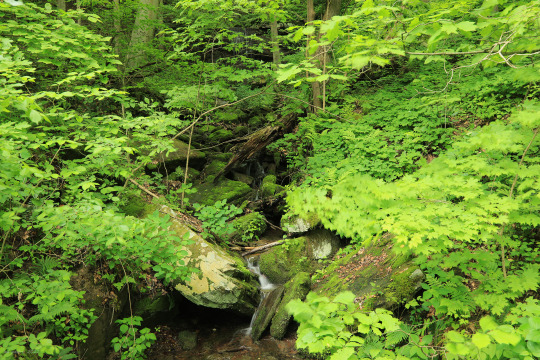
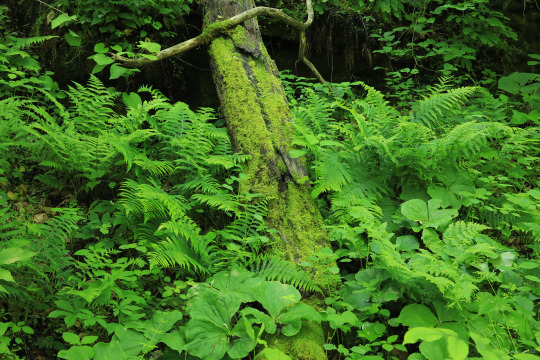
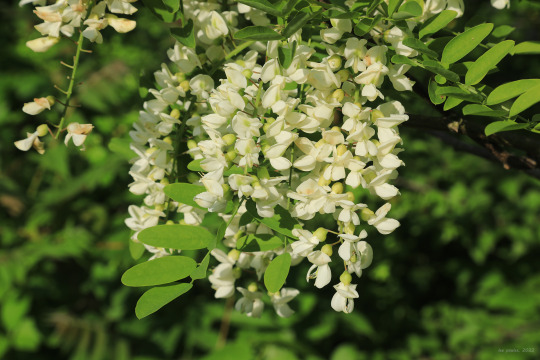

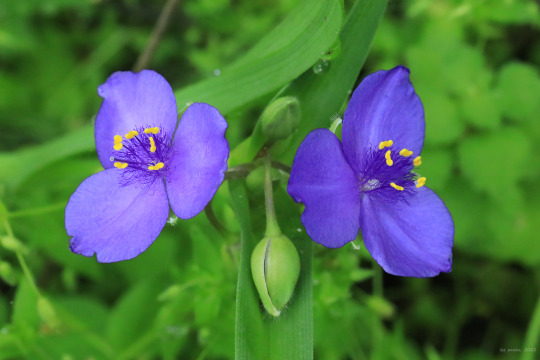

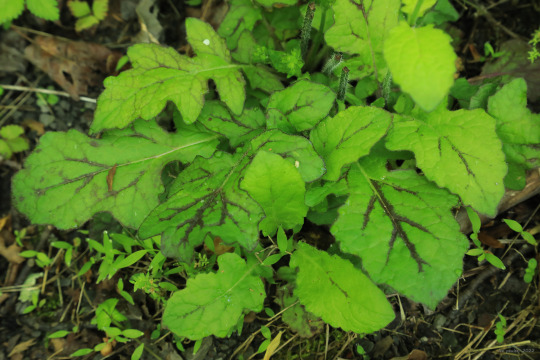



It was such a glorious Saturday morning, I couldn’t pass up a bike ride on the Mon River Trail. It’s hard to believe the spring ephemerals are mostly gone now that the canopy has closed in, but Mother Nature doesn’t doddle. As compensation, she has given us stunning new greens and a lush carpet of ferns.
From top: black locust (Robinia pseudoacacia), a Central Appalachian endemic that has been widely cultivated outside of its native range and is now naturalized in many other parts of North America and Europe; American bladdernut (Staphylea trifolia), a large, suckering shrub that forms the most amazing fruit, encased in a three-chambered bladder; Virginia spiderwort (Tradescantia virginiana), which despite its unappealing name is an absolutely gorgeous, spring-blooming dayflower; lyreleaf sage (Salvia lyrata L.). a highly appealing spring-blooming mint with incredibly showy foliage; Philadelphia fleabane (Erigeron philadelphicus), distinguished from other spring asters by it clasping leaves; Virginia waterleaf (Hydrophyllum virginianum), an edible green sometimes referred to as Shawnee salad; and Canada violet (Viola canadensis), one of the last and most stately violets to bloom in this area.
#appalachia#vandalia#west virginia#mon river trail#spring#wildflowers#flora#robinia pseudoacacia#black locust#staphylea trifolia#american bladdernut#tradescantia virginiana#virginia spiderwort#salvia lyrata#lyreleaf sage#erigeron philadelphicus#philadelphia fleabane#hydrophyllum virginianum#virginia waterleaf#shawnee salad#viola canadensis#canada violet
158 notes
·
View notes
Text
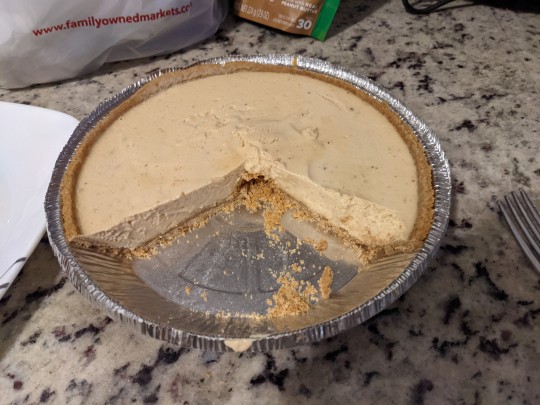

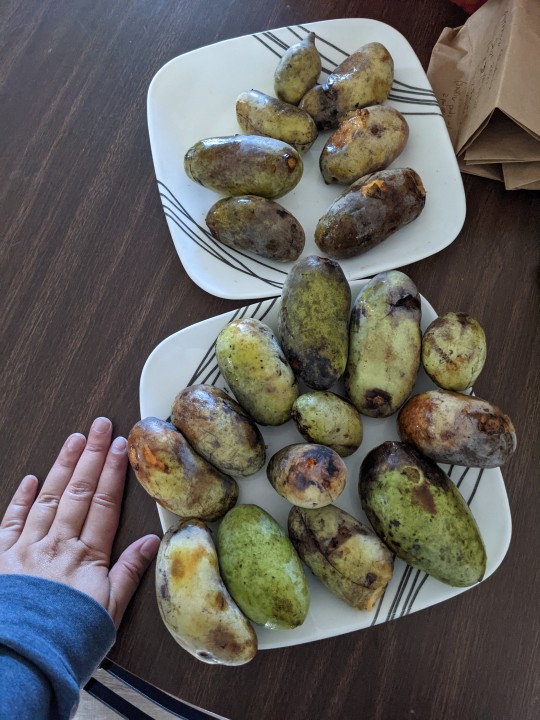
Gathered pawpaws with a friend this morning, and made my share into a cheesecake!!
Always thought they were cool but never knew there were SO many so close by, or THIS FRICKIN DELICIOUS!! They really do taste like a mango-y banana pudding. They also smell so nice, very fragrant and pleasant. c:
#Saved lots of seeds obviously! I also collected (hybrid?) oak acorns#spicebush berries#and a LOT of aerial tubers from invasive chinese yam. I've also got an interesting collection of american bladdernut seeds#which i seem to be finding in weird places. like next to a fast food place#very cool trees!!! just not a lot of info on them
18 notes
·
View notes
Photo
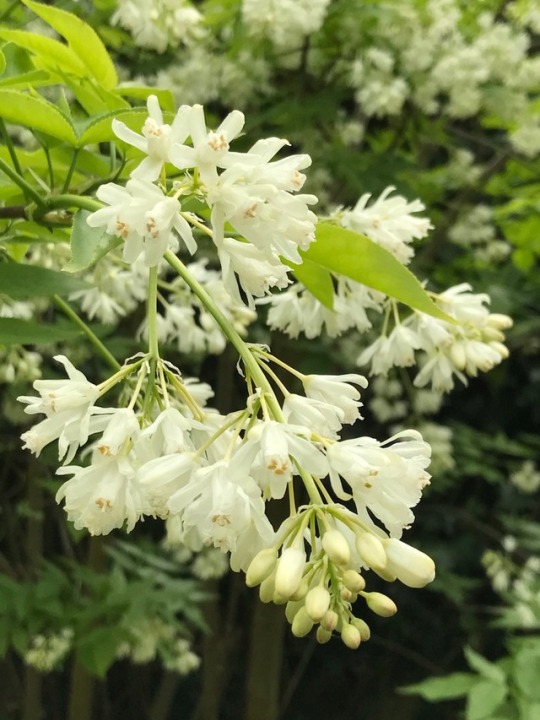


Plant of the Day
Saturday 22 April 2017
The upright, deciduous shrub Staphylea colchica (bladdernut) has been flowering for a month with small, white, fragrant, bell-shaped flowers in hanging clusters. In the summer there will be large, greenish-white, inflated fruit. This plant is easy to grow in any moist, well-drained soil in sun or semi-shade. I had a pink cultivar as 'Plant of the Day' on Sunday 26 March 2017 so that indicates how long they can be flowering.
Jill Raggett
#Staphylea#bladdernut#deciduous shrub#deciduous tree#deciduoustree#spring flowering#flowering shrub#flowering tree#white flowers#wucplant#writtledesign#mhort#pashley manor#pashleymanor
73 notes
·
View notes
Photo
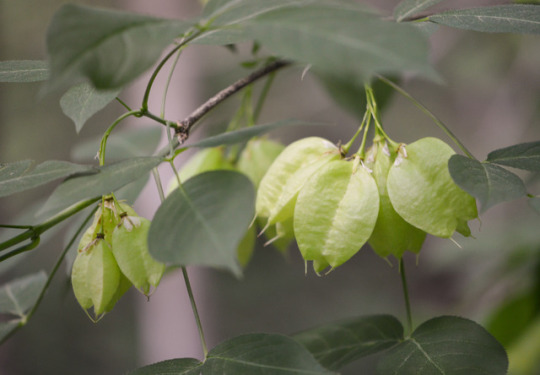
The not-so-elegantly named bladder nut tree 🌿
mbrooks l insta l facebook l flickr
3 notes
·
View notes
Photo

American Bladdernut, Staphylea trifolia (by me)
#American Bladdernut#Staphylea trifolia#Staphylea#Staphyleaceae#Crossosomatales#shrub#seed pods#spring#Highland Park#Middlesex County#New Jersey#mine
15 notes
·
View notes
Text
Safe Aviary Plants and Toxic Plants for Birds@|what plants can i put in an outdoor aviary@|@|24
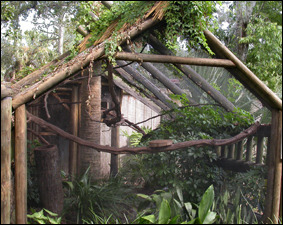
Plants not only add aesthetic value to an otherwise sterile-looking enclosure, but they also provide a more natural, engaging, and secure environment for the inhabitants to enjoy. Using plants to create visual barriers within the flight may help reduce aggression among cagemates by providing objects for the birds to hide behind.5 This in turn helps to make the birds feel more secure, and may therefore result in reduced stress levels. Foliage in the cage gives the birds something to occupy themselves with–birds often chew on, play within, and even build nests out of plants placed in their living space.
For this reason, care must be taken when selecting plants to decorate a flight. Both live and fake plants may be used, but all parts of the plant must be safe and nontoxic. The best fake plants to use are constructed of untreated silk and plastic. Make sure the silk plants do not have any components that may be easy for a bird to consume, tangle itself in, get caught on, or stuck by. Treated wood baskets and paper plants may be hazardous choices and are not recommended for decorating flights. Two benefits of using silk plants are: 1) they are not as easily destroyed by the birds, and 2) they can be scrubbed clean and disinfected as needed.
[external_link_head]
Live plants tend to demand more upkeep and may need to be replaced more frequently, as finches often love to pick them apart. Try to obtain plants that have not been sprayed with any pesticides or chemicals, and be sure to rinse the plants off before placing them in and around the flight. Do not add any fertilizers to the soil (they are toxic);6 if fertilizers are already present in the soil, repot the plant with uncontaminated soil. Leaving each plant in its pot is suggested, in case a plant dies and needs to be removed.
Helpful Hints41
Placement
Plantings should be spaced appropriately to allow room for flight paths and to permit the birds to access to the floor of the enclosure. Walk-in enclosures should also have planned pathways for birdkeeper access. Be careful to provide climbing vines with trellis to support the weight of their growth; otherwise they could break the aviary mesh and allow escape of the birds.
Selection
Aside from ensuring that the plant(s) you have selected are non-toxic, try to avoid purchasing plants which are tall and rapidly-growing as these will require constant pruning. In addition to considering what plants are best suited for your area, don’t forget to also consider the needs of the birds. Avadavats and Munias enjoy climbing small bamboos and grasses, for example, Munias and Mannikins prefer to weave their nests into grass clumps, and Weavers need palm leaves and broad-leafed grasses for nesting material.
Timing of Live Plantings
Plants should be added to the enclosure as it is being completed. The plants should be allowed to grow sufficiently before adding the birds; this way, the plants will be better able to withstand being nibbled on. Ideally plants should produce their densest foliage while the birds are nesting.
Safe Aviary Plants25,17
When choosing plants for your aviary, consult a botanist or experienced gardener who can help you select plants which are suitable for planting in your locale (considering your hardiness zone, soil type, sun exposure, etc.). Below are some options which have been listed as safe for birds.
Note: Please be aware that roses and bougainvillea have thorns.
Outdoor Plants
Trees & Shrubs
Acacia
Almond
Arbutus
Ash

Aspen
Autumn olive
Bayberry
Birch
Bladdernut
Blueberry
Camellia
Cottonwood
Dogwood
Elm
Fir (balsam, douglas, subalpine, white)
Forsythia
Fuchsia
Guava
Hawthorn
Larch
Madrona
Magnolia
Mango (zone 9+)
Manzanita
Mountain ash
Nectarine
Papaya (zone 10+)
Pear (as long as the seeds aren’t eaten)
Pine (ponderosa, spruce, Virginia, white)
Pittosporum (zone 9+)
Poplar
Pyracantha
Raspberry
Rose
Rubus odoratus
Spruce (black, Norway, red, white)
Viburnum
White poplar
Vines
Bougainvillea (can also be grown as shrub or small tree)
Grape vine
Russian Vine (Polygonum baldschuanicum)
[external_link offset=1]
Grasses & Herbs
Bamboo
Oregano
Rosemary
Thyme
Ground Cover and Short Plants
Baby’s tears aka Polka Dot Plant (Helxine soleirolii)
Chickweed
Creeping jenny (Lysimachia)
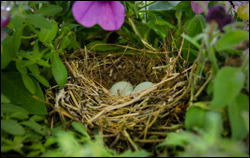
Wild passerines built a nest in a hanging petunia.
Dandelion
Marigold
Mother of pearl
Nasturtium (zone 9+)
Petunia
Piggyback begonia (Begonia hispida variant Cucullifera)
Piggyback plant
Plectranthus (zone 9+)
Sedum
Thistle
White clover
Indoor Plants (Safe Houseplants) and Tropical Plants
African violet (Saintpaulia spp., Episcia reptans)
Aluminum plant (Pilea cadierei)
Bird’s Nest Fern (Asplenium nidus)
Boston Fern (Nephrolepis exaltata)
Bloodleaf
Bromeliads
Burro’s tail
Cactus (except pencil, peyote, mescaline, candelabra)
Christmas cactus (Schlumbergera bridgesii)
Cissus: Danish ivy aka Grape Ivy (Cissus rhombifolia), Kangaroo vine (Cissus antarctica)
Emerald ripple peperomia
Flame nettle (Coleus sp.)
Gold-fish plant
Hens & chickens
Lipstick plant
Madagascar jasmine
Monkey plant
Nerve plant
Palms:

Potted palms provide privacy around the nest.
Areca (Chrysalidocarpus lutescens)
Bamboo (Chamaedorea erumpens)
Butterfly Cane
Canary Island (Phoenix canariensis)
Date
European Fan (Chamaerops humilis)
Fishtail
Golden Feather
Paradise/Kentia (Howea foresterana)
Parlor (Chamaedorea elegans)
Lady (Raphis excelsa)
Madagascar
Miniature Fan
Phoenix
Pygmy Date
Robelein Lady
Sentry
Wine
Peacock plant (Calathea)
Pepperomia (Pepperomia sp.)
Prayer plant (Maranta leuconeura)
Purple Passion aka Velvet Plant (Gynura aurantiaca)
Spider plant (Chlorophytum comosum)
Swedish ivy (Plectranthus verticillatus)
Wandering jew (Tradescantia sp.) including Giant white inch plant
Wax plant (Hoya carnosa)
Zebra plant (Aphelandra squarrosa)
Plants which Allow for Perching
Dwarf or Hawaiian Schefflera (Schefflera arboricola)
Umbrella tree/Schefflera (Brassaia actinophylla)
False aralia
Toxic Plants
Plant toxicosis in birds occurs if they chew on or ingest toxic plants. The toxic reaction can be due to pesticide residues on the plants, or to toxins within the plants themselves. Birds which chew on toxic plants may develop oral irritation; if they ingest enough, systemic clinical signs can occur such as vomiting or diarrhea. There is likely significant species differences in sensitivity,16 and studies are lacking. However, plants which have been reported as toxic in some birds, or which are considered to be potentially toxic include:6,25,52,29,56,16,17,28
Common Name Scientific Name Poisonous Part Symptoms Aconite Aconitum sp. all parts Agapanthus Agapanthus sp. sap Amaryllis Amaryllidaceae bulbs American yew Taxus canadensis needles, seeds Apple seeds Apricot pits Arrowhead vine Syngonium podophyllum leaves Arum Lily Arum sp. all parts Autumn crocus Colchicum autumnale all parts Avocado Persea americana pits, skin, flesh Reduced activity, inability to perch, fluffing feathers, labored breathing, rapid death, generalized tissue congestion. Azalea Rhododendron occidentale leaves Balsam pear Memordica charantia seeds, fruit rind Baneberry Actaia sp. berries, roots Bay tree Laurus nobilis Beans all types if uncooked Belladonna Atropa belladonna all parts Bird of paradise Caesalpina gilliesii seeds Bishop’s weed Ammi majus Bittersweet nightshade Solanum dulcamara immature fruit Black locust Robina pseudoacacia bark, sprouts, foliage Blue-green algae Schizophycaea sp. some forms toxic Hepatotoxic, lethal respiratory arrest. Boxwood Buxus sempervirens leaves, stems Buckthorn Rhamnus sp. fruit, bark Burdock Arctium minus Buttercup Ranunculus sp. sap, bulbs Caladium Caladium sp. leaves Calla lily Zantedeschia aethiopica leaves Severe irritation of mucous membranes, edema & irritation may take weeks to subside; severe dyspnea; severe keratoconjunctivitis if plant juices contact eyes. Vomiting, diarrhea. Camel bush Trichodesma incanum Candelabra cactus Euphorbia lactea sap Castor bean or Castor oil plant Ricinus communis beans, leaves Vomiting, diarrhea (possibly bloody), necrosis of organs (liver, spleen, lymph nodes, stomach, intestine) in mammals. Chalice vine Solandra sp. all parts Cherry bark, twigs, leaves, pits Cherry laurel Prunus laurocerasus clippings release cyanide fumes Chinese evergreen Aglaonema modestum all parts Christmas candle Pedilanthus tithymaloides sap Chrysanthemum Chrysanthemum sp. leaves, stems, flowers Clematis Clematis sp. all parts Coffee bean Sesbania sp seeds Gastroenteritis, can be fatal. Hyperthermia, hypertension, hyperactivity, seizures, tachycardia. Coral plant Jatropha multifida seeds Cowslip Caltha polustris all parts Croton Codiaeum sp. sap Crown of thorns Euphorbia milii sap Daffodil Narcissus sp. bulbs Daphne Daphne sp. berries Datura Datura sp. berries Deadly amanita Amanita muscaria all parts Death camas Zygadenis elegans all parts Delphinium Delphinium sp. all parts Diffenbachia or Dumb cane Dieffenbachia picta, sp. leaves Severe irritation of mucous membranes, edema & irritation may take weeks to subside; severe dyspnea; severe keratoconjunctivitis if plant juices contact eyes. Vomiting, diarrhea. Eggplant Solanaceae sp. all parts except fruit Elephant’s ear Colocasis sp. or Alocasia sp. leaves, stems Severe irritation of mucous membranes, edema & irritation may take weeks to subside; severe dyspnea; severe keratoconjunctivitis if plant juices contact eyes. Vomiting, diarrhea. English ivy Ilex aquafolium berries, leaves English yew Taxus baccata needles, seeds Ergot Claviceps purpurea present in poorly stored seed, silage, dog food Gangrene, hyperexcitability, seizures. Euonymus Euonymus sp. all parts False henbane Veratrum woodii all parts Flamingo flower Anthurium sp. leaves, stems Foxglove Digitalis purpurea leaves, seeds Digitalis glycoside – vomiting, bradycardia, arrhythmias, heart block Golden chain Laburnum anagyroides all parts Hemlock (poisoin and water) Conium sp. all parts Henbane Hyocyanamus niger seeds Holly Ilex sp. berries Horse chestnut Aesculus sp. nuts, twigs House plant ferns Pteris sp. Hyacinth Hyancinthinus orientalis bulbs Hydrangea Hydrangea sp. flower bud Iris Iris sp. bulbs Ivy Hedera sp. leaves, berries Jack-in-the-pulpit Arisaema triphyllum all parts Japanese yew Taxus cuspidata needles, seeds Java bean (lima bean) Phaseolus lunatus uncooked beans Jerusalem cherry Solanum pseudocapsicum berries Arrhythmias, bradycardia, heart block, severe gastroenteritis, calcification of vascular system, lungs, kidneys. May be teratogenic. Jimsonweed Datura sp. leaves, seeds Tachycardia, convulsions, death. Juniper Juniperus virginiana needles, stems, berries Lantana Lantana sp. immature berries Larkspur Delphinium sp. all parts Laurel Kalmia, Ledum, Rhodendron sp. all parts Lily Lilium sp. bulbs Lily of the valley Convallaria majalis all parts, including water housing the plant Vomiting, diarrhea, cardiac arrhythmias, bradycardia, heart block. Lobelia Lobelia sp. all parts Locoweed Astragalus mollissimus or Astragalus emoryanus all parts Hyperexcitability and locomotor difficulty. Lords and ladies Arum sp. all parts Lupin Lupinus sp. Marijuana Cannabis sativa leaves Maternity plant Klanchoe sp. Mayapple Podophyllum sp. all parts except fruit Mescal bean Sophora sp. seeds Milkweed Asclepias sp. Weakness, ataxia, seizures, cardiovascular signs. Mistletoe Santalales sp. berries Mock orange Poncirus sp. fruit Monkshood Aconitum sp. all parts Morning glory Ipomoea sp. all parts Narcissus Narcissus sp. bulbs Nightshades Solanum sp. berries, leaves Arrhythmias, bradycardia, heart block, severe gastroenteritis, calcification of vascular system, lungs, kidneys. May be teratogenic. Oak Quercus sp. Anorexia, diarrhea, small intestinal ulceration and hemorrhage, renal failure & polydypsia, hepatotoxic, can be fatal. Oleander, bay laurel Nerium oleander all parts Digitalis glycoside – vomiting, bradycardia, arrhythmias, heart block Parlor ivy Senecio sp. all parts Parsley Petroselinum sativum Peace lily Spathiphyllum sp. Regurgitation, oral pain, dysphagia and anorexia Peach pits Pencil tree Euphorbia tirucalli sap Philodendron Philodendron sp. leaves, stems Severe irritation of mucous membranes, edema & irritation may take weeks to subside; severe dyspnea; severe keratoconjunctivitis if plant juices contact eyes. Vomiting, diarrhea. Poinsettia Euphorbia pulcherrima leaves, flowers, stem, oily white sap Irritation, vesication, gastroenteritis, conjunctivitis. Poison ivy Toxicodendron radicans sap Poison oak Toxicodendron quercifolium sap Poison sumac Toxicodendron vernix sap Pokeweed Phytolacca americans leaves, roots, berries Ulcerative gastroenteritis; acute hemolytic crisis in people. Potato Solanum tuberosum skin, eyes, new shoots Arrhythmias, bradycardia, heart block, severe gastroenteritis, calcification of vascular system, lungs, kidneys. May be teratogenic. Pothos Epipremnum aureum all parts Regurgitation, oral pain, dysphagia and anorexia. Precatory bean Arbus precatoius Privet Ligustrum volgare all parts Ranunculus Ranunculus sp. sap Rhododendron Rhododendron sp. all parts Rhubarb Rheum rhaponticum leaves Rosary pea, prayer beans, Seminole beads Abrus precatorius seeds Vomiting, diarrhea (possibly bloody), necrosis of organs (liver, spleen, lymph nodes, stomach, intestine) in mammals. Sago Palm, Zamia Palm, Cycad Palm Cycad sp. Liver failure. Skunk cabbage Symplocarpus foetidus all parts Snowdrop Orinthogalum unbellatum all parts Snow on the mountain (ghostweed) Euphorbia marginata all parts Spindle tree Euonymus japonica all parts Split leaf philodendron or Swiss cheese plant Monstera sp. all parts Sweet pea Lathyrus latifolius seeds and fruit Tobacco Nicotinia sp. leaves Vomiting, diarrhea, hyperexcitability, muscle fasciculations, seizures, rapid death. Pododermatitis if bird handled by a smoker. Coughing, sneezing, sinusitis, conjunctivitis, secondary respiratory infections if exposed to cigarette smoke. Umbrella plant Cyperus alternifolius leaves Virginia Creeper Parthenocissus quinquefolio sap Western yew Taxus breviflora needles, seeds Wisteria Wisteria sp. all parts Xanthosoma Xanthosoma sp. leaves Yam bean Pachyrhizus erosis roots, immature pods Yellow jessamine Gelsemium sempervirens flowers Yew Taxus media wood, bark, leaves, seeds Vomiting, diarrhea, weakness, shock, coma, seizure, deaths from cardiac or respiratory failure.
Avian Plant Toxicology Research
Studies of plant toxicity in finch species are greatly lacking, however a few studies were done using canaries. Unfortunately, because great variation exists among species, it is not safe to assume that plants which are non-toxic to canaries are equally safe to other birds and vice versa.
[external_link offset=2]
AUTHOR(S): Arai, M.; Stauber, E.; Shropshire, C. M.
TITLE: Evaluation of selected plants for their toxic effects on canaries.
YEAR: 1992 CITATION: J Am Vet Med Assoc, 200(9), +61404532026
ABSTRACT: Leaves or fruit from 14 plants considered to be toxic to pet birds were administered by gavage to 15 pairs of canaries (Serinus canaria). Each bird was given 0.12 to 0.70 g of plant material. One pair served as a control and was given distilled water. The plant materials were flash-frozen in liquid nitrogen, pulverized, and resuspended in deionized water for administration. Of the plants tested, 5 (
oleander, lupine, foxglove, yew leaves, and dieffenbachia) were considered highly toxic and were associated with acute death of birds. The remaining plant samples (clematis, Hoya carnosa, privet Ligustrum vulgare, parsley Petrosilium sativum, cherry Prunus sp., Pyracantha coccinia, rhododendron, black locust Robinia pseudoacacia, and wisteria) caused no, or only transient, clinical illness.
AUTHOR(S): Hargis, A. M.; Stauber, E.; Casteel, S.; Eitner, D.
TITLE: Avocado (Persea americana) intoxication in caged birds.
YEAR: 1989 CITATION: J Am Vet Med Assoc, 194(1), 64-66
ABSTRACT: Following two incidents in which a pet canary and three pet cockatiels died under conditions suggesting ingestion of avocado as cause of death, an experimental study was undertaken. Avocados of two cultivars were mashed and administered via feeding cannula to 8 canaries and 8 budgerigars. Two control budgerigars were given water via feeding cannula. Six budgerigars and 1 canary died within 24 to 47 hours after the first administration of avocado.

Deaths were associated with administration of both avocado cultivars. Higher dose was associated with greater mortality. The 2 budgerigars given water were normal throughout the observation period. It is concluded that avocados are highly toxic to budgerigars and less toxic to canaries. PM findings observed in some birds included subcutaneous oedema in the pectoral area and hydropericardium.
The following study was done using just budgies:
AUTHOR(S): Shropshire, C. M.; Stauber, E.; Arai, A.
TITLE: Evaluation of selected plants for acute toxicosis in budgerigars.
YEAR: 1992 CITATION: J Am Vet Med Assoc, 200(7), 936-939
ABSTRACT: Pairs of budgerigars were given samples, by gavage, of plants considered potentially toxic to pet birds. Samples were prepared by flash-freezing and powdering fresh plant material in liquid nitrogen and resuspending the material in deionized water for administration. Of the 19 plants tested, only 6 induced clinical signs of illness; these plants included
yew, oleander, clematis, avocado, black locust, and Virginia creeper (Taxus media, Nerium oleander, Clematis sp, Persea americana, Robinia pseudoacacia, Parthenocissus quinquefolio).
The other plants tested in this study were: bleeding heart (Lamprocapnos spectabilis), privet (Ligustrum sp.), honeysuckle (Lonicera sp.), lupine (Lupinus sp.), cherry (Prunus sp.), pyracantha (Pyracantha coccinea), boxwood (Buxus sp.), dumbcane (Dieffenbachia seguine), foxglove (Digitalis sp.), spindle bush (Euonymus alatus), poinsettia (Euphorbia pulcherima), rhododendron (Rhododendron sp.), and blue elderberry (Sambucus cerulea).
Note how some plants which appear well tolerated by budgies (lupine, dieffenbachia, foxglove) prove fatal to canaries, while some plants which canaries appear to tolerate (clematis, black locust) make budgies quite ill. Until more research is done, it is important to err on the side of caution and avoid any plant which may potentially be toxic. [external_footer]
source https://livingcorner.com.au/safe-aviary-plants-and-toxic-plants-for-birdswhat-plants-can-i-put-in-an-outdoor-aviary24/
2 notes
·
View notes
Text
Lotta things to be said but I’m just gonna say that I want to find some kind of shrub to plant over Muffin Man’s grave. It’s not the hottest of spots for much of any kind of plant but I really really do want that, as a cross/stones is just more trouble.
Bladdernut would be imo the sturdiest choice (can deal with drought and shade, bonus points for being native and I like its occasionally fountainous form) but I don’t have any plants in my greenhouse or access to any plants from the wild or nurseries either. I have Kousa Dogwood, Buttonbush, and Swamp Rose, but I’m not sure it’s gonna be moist enough for any of the three, and I’m definitely not sure it’ll be sunny enough either (basically the spot is closely sandwiched between the little toolshed from the East and the Spruce windbreak from the West).
Maaaannn it’s hard to think of many choices for such spots.
#would rather use shrub species that I can get either from my greenhouse or the wild but that's easier said than done#ramblings
2 notes
·
View notes
Photo
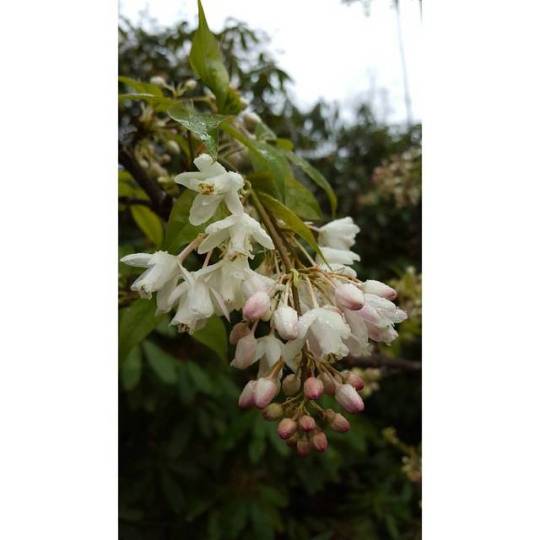
Staphylea trifolia (American bladdernut) Already in bloom... #cokerarboretum #ncbg #northcarolinabotanicalgarden #unc #chapelhill #trees #springflowers #staphylea #staphyleatrifolia #bladdernut #native #nativeplants #nativeflora #nativetrees #gffry (at Coker Arboretum)
#bladdernut#native#nativeflora#gffry#staphylea#nativeplants#unc#springflowers#nativetrees#staphyleatrifolia#chapelhill#trees#ncbg#northcarolinabotanicalgarden#cokerarboretum
0 notes
Photo



Eastern Wild Hydrangea
Hydrangea arborescens
If you’ve ever enjoyed a limestone gorge in June or July, you’ve seen the snow white showy blossom of this tall cliff side Hydrangea.
I feel like there is always a smile on my face when I see a bankside population of these surrounded by lobelia, bladdernut, jewel weed, and common wingstem.
Photographed at Glen Helen Ecological Institute and Natural Area, Yellowsprings, Ohio
#Hydrangea arborescens#white flowers#wild flowers#wildflowers#nature#plants#plant#plantblr#botany#photography#ohio
20 notes
·
View notes
Photo
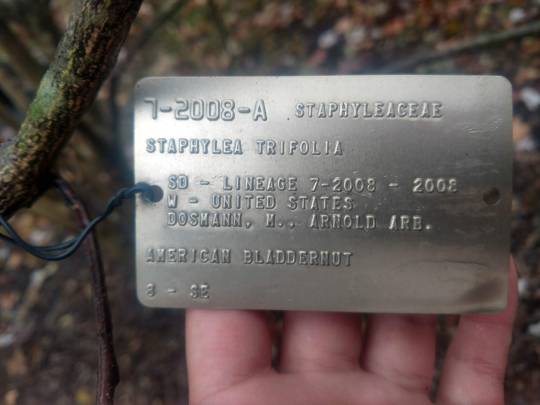
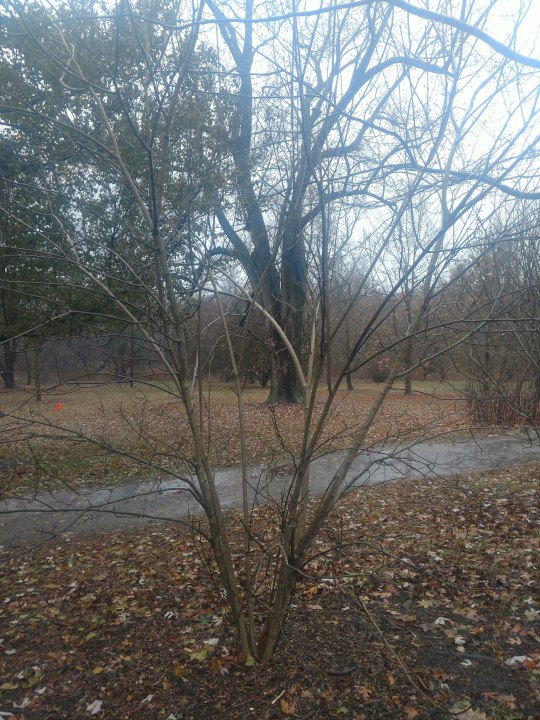
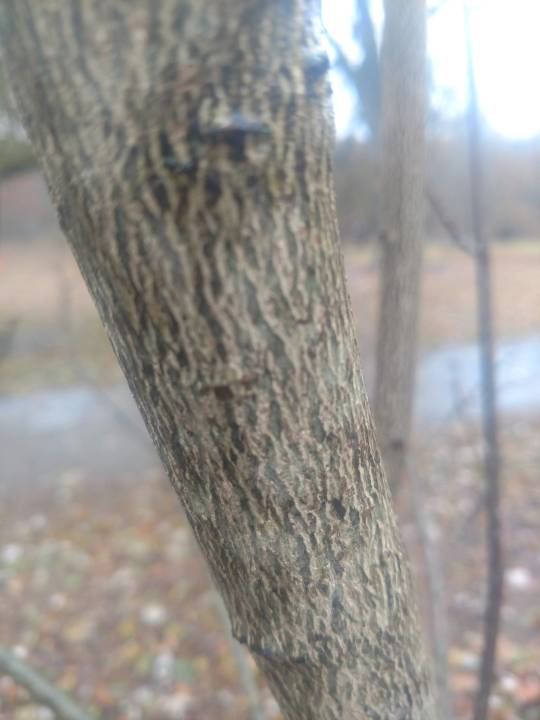

American Bladdernut • Staphylea trifolia
Plant Community: N/A
Native Status: Native to the eastern North America
Mature Size (h, w): 10-15 ft, 10-20 ft
Habitat/Preferred Conditions: Partial to full shade. Average, medium to dry soils. Tolerant of a wide range of soils.
Eco-indicator: N/A
Hardiness zone: 3-8
Leaf Color: Green (Summer)
Flower Color: White
Bloom Time: April-May
Theme:
The American Bladdernut, despite what the name may imply, does not offer significant pollinator support in the form of mast. In fact, this species remains largely unbrowsed for its mast, even by deer who do not favour the tree.
However, the flowers do offer support to insect pollinators, such as bees and other insects, who consume the nectar and harvest pollen from the showy blossoms. These insects include bumblebees

http://blogs.bu.edu/biolocomotion/2011/12/09/misconceptions-of-the-bumblebee-an-in-depth-analysis-of-an-aerodynamic-marvel/
as well as Halictid Bees,
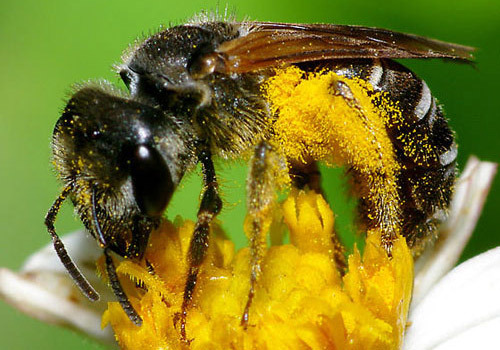
http://entomology.ifas.ufl.edu/creatures/misc/bees/halictid_bees.htm
Andrenid Bees,
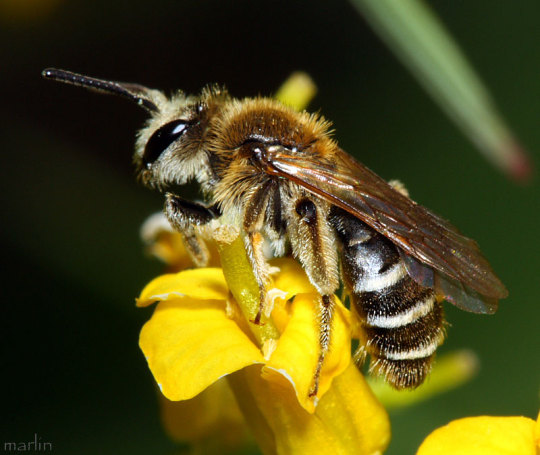
http://www.cirrusimage.com/Hymenoptera/andrenidae_queen.JPG
and Honey Bees

https://en.wikipedia.org/wiki/Western_honey_bee
Sources:
http://www.missouribotanicalgarden.org/PlantFinder/PlantFinderDetails.aspx?taxonid=287254&isprofile=1&basic=Bladdernut
https://plants.usda.gov/core/profile?symbol=STTR
http://grownative.org/plant-picker/plant/bladdernut/
https://www.mortonarb.org/trees-plants/tree-plant-descriptions/american-bladdernut
http://illinoiswildflowers.info/trees/plants/bladdernut.htm
0 notes